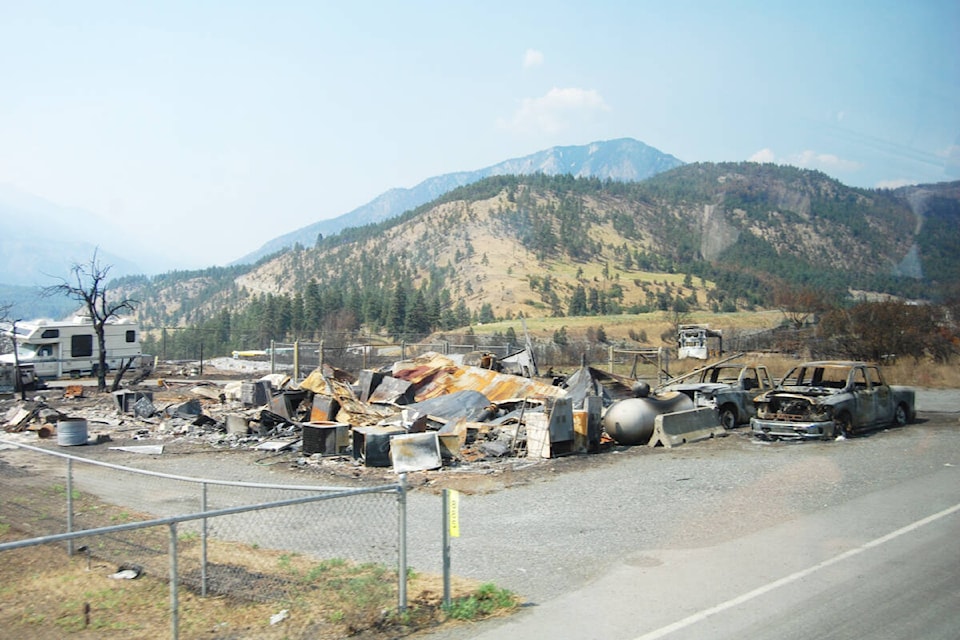Two proposed new bylaws, and one amending bylaw, for rebuilding the Village of Lytton were explained to residents at an online open house on Feb. 16. The meeting came after several months of discussion about how to “build back better” in the community, 90 per cent of which was destroyed by a fast-moving fire on June 30, 2021 which left two people dead.
The bylaws have been given first reading by council, and the meeting was an opportunity for residents to ask questions and make comments to be considered by council prior to second reading.
The main bylaw is Building Bylaw number 710, which would incorporate step three of B.C.’s energy step code. It is an optional part of the BC Building Code that local governments can use to require a level of energy efficiency in new construction that goes above and beyond the requirements of the code. Step three reduces the use of greenhouse gases, reduces heat demand, and creates a more comfortable living space.
Bylaw 711 — which would apply to the entire village, not just the downtown area — is an amendment to bylaw 710, and relates to a number of conditions specific to Lytton. It would lead to buildings that would help reduce, but not eliminate, the threat of fire damage in the future, by implementing fire safe building requirements, structural ignition zones, safer homes standards, and vegetation maintenance.
The fire safe building requirements include no mobile or log homes; modular homes only if they meet specific fire safe building requirements; Class A fire rated roofing material; one hour fire resistant exterior walls; fire rated exterior wall finish material; exterior door and window assemblies that have a 20 minute fire resistance rating; non-combustible decks, balconies, and fences; and LPG tanks on concrete pads that are a minimum of 33 feet from all buildings. It was noted that this last requirement could make it very difficult to have propane tanks on most properties within the village, because of proximity to buildings on other nearby properties.
It was clarified that owners of existing buildings would probably only be affected by the proposed bylaw changes if they were to require a building permit for changes/additions to their property.
Structural ignition zones would apply to all new and existing buildings within the village. All land within five feet of the building eaves would be bare soil covered with non-combustible material, while land between five and 33 feet of the building would contain vegetation that is less fire-prone, no debris or fire wood, and no trailers, storage sheds or accessory buildings except structures built to the same standards as the house. Any land more than 33 feet from a building would have reduced fire loads, such as vegetation that is continually pruned and thinned.
Denise O’Connor noted that the Insurance Bureau of Canada has said that insurance will not cover the cost of meeting bylaws that come into place after a fire, and asked if the village would consider “grandfathering in” residents who want to rebuild according to the previous bylaw. She also asked if policy would be developed around how the village looked after vegetation maintenance on village-owned property.
One person asked if, given the municipal elections in October, a new council could rescind the proposed new bylaws if they were passed. The answer was that a new council can amend or rescind any existing bylaws as long as the proper legal and legislative processes are followed, but that any change could create issues for people who are in the process of building.
Judith Urquhart asked about people parking vehicles in their yard: not only any vehicle they currently used, but uninsured vehicles. She was told that people could park insured vehicles in their yard, while uninsured vehicles would be covered under other bylaws, such as an unsightly premises or good neighbour bylaw.
Jessoa Lightfoot asked if the village had any legislation over railways, or any way to make them comply with the bylaw requirements around vegetation. The answer was no, as railways are federally regulated and therefore not subject to municipal or provincial legislation. The only option would be for the village to enter into a service agreement with the railways whereby the village or a non-profit entity would enter into a contract to look after the rail lines within, and just outside, the village. She also received clarification that planters and trees would not be allowed in the five-foot zone close to a building, or immediately in front of a commercial building.
It was also clarified that while the bylaws do not call for an interior sprinkler system in residential buildings, there is nothing to stop a homeowner from installing one. These interior systems are different to the exterior sprinkler systems that were used in some places, such as Logan Lake, during last year’s fire season.
Nonie McCann asked if homeowners would receive guidance as to where approved materials are available, or a list of approved/not approved plants and trees. She was told that all the required materials are available, although not necessarily everywhere, and that more specific information would be forthcoming when the final details of the bylaws were settled. It was also noted that step three requirements have been in place in many municipalities for some time, and should incur few if any additional costs above what was previously required under the building bylaw, but would provide many additional benefits in the short- and long-term.
A question about solar panels prompted the reply that the panels are fire rated, do not cause or spread fires, and would be allowed under the new bylaws. The difficulty in Lytton would be finding solar panels that can withstand the snow load in winter.
The bylaws in question are scheduled to be given second reading at the Lytton council meeting on March 9. It is anticipated that the bylaws could be in place by the end of March.
editorial@accjournal.ca
Like us on Facebook and follow us on Twitter
